Introduction
Crowdfunding is rapidly grown as an alternative means of financing for new start-up business. Crowdfunding has become a more common method used by businesses to acquire funds to support new projects or businesses. With the help from the online community, project owners may reach potentially large pool of investors to participate in entrepreneurial finance activities. The latest report has shown that the transaction value in crowdfunding market is estimated to reach US$0.62m in 2024 (Statista. 2024). Social capital is a sociological concept that highlights the importance of social networks, trust, obligation and shared value to understand the investors’ behaviours toward crowdfunding platform. Lin and Pursiainen (2018) reveal that interpersonal connections and networks play a vital role in the success and dynamics of crowdfunding campaign aligned with the social capital theory.
Over the past five years, crowdfunding has grown its popularity as a method of supporting commercial firms and businesses. Globally, the total volumes of crowdfunding had increased significantly although the annual growth rates are progressively slowing. In Asia, Malaysia is recognized as the first country to implement a regulator framework for crowdfunding platforms for start-ups (Hoque et al., 2023). The Securities Commission has introduced the Guidelines on Recognised markets mainly for the Equity crowdfunding (ECF) platforms with the aim to assist entrepreneurs and small businesses for capital raising by selling equity or ownership interests to a large pool of investors. As noted, crowdfunding in Malaysia started in the early 2010 which involved community-based initiatives and charity campaigns.
The development of crowdfunding has gained attention for researchers to get into the study of its growth phenomenon (Martínez-Climent et al., 2018; Mochkabadi &Volkmann, 2020). Earlier study by Belleflame et al. (2014) classified the benefits earned from the backers in crowdfunding into four models: donation, reward, lending and equity. Moritz and Block (2016) later studied the main players in crowdfunding namely the capital-provider, capital-seekers and intermediaries. Mochkabadi and Volkman (2020) then broaden the scope of the study with the inclusion of capital market and institutional perspective. Due to its new concept and practices of fund raising, the knowledge and the conceptual development around crowdfunding is still minimal. Therefore, the review on crowdfunding should not only expand its theory development (Webster & Watson, 2002) but also better conceptualize the topic too (Beaulieu et al., 2015).
Humans naturally evolved to be social and working collectively to achieve goals. Things were done with the efforts of others be they in the forms of cooperation or reciprocity. The benefits derive from the collective efforts and arise from considerations from others to act generously and cooperatively which is called social capital (Claridge, 2018). Various crowdfunding research studies may focus on charity and donating public goods (Burtch et al., 2013; Kuppuswamy & Bayus, 2018), and lending and equity such as by Ahlers et al. (2015), and Bapna (2019) and Vismara (2018) who focused on signalling and information cascades. Social capital theory set in into numerous types of facades where the concept is wide and covers varieties of elements such as trust, networks, obligation and shared values. Due to the various facets, there is a need to bring together different types of study and theoretical development. Analysing the mechanisms of social capital in crowdfunding activities is important, especially to better understand their influence on crowdfunding. Earlier researchers such as Mollick (2014) and Vismara (2016) studied crowdfunding using a static view to test on social capital prediction to a success of a campaign and investors’ behaviours (Chen et al., 2014). Later, the study on crowdfunding emphasized the role of social capital and its evolvement that contribute to the crowdfunding dynamics (Dai et al., 2019; Buttic`e et al., 2017; Colombo et al., 2015; Skirnevskiy et al., 2017).
Social capital theory gained attention in the crowdfunding research and is one of the main facets of developing the theory on crowdfunding. The concept of seeking financial help from others suits the nature of crowdfunding, which signifies the funds derive from social relationships (Payne et al., 2011). Therefore, it can be said that the social capital in crowdfunding is favourable to the businesses in helping them financially. Social capital is very beneficial to the society as a whole and projects public good behaviour and contributions (List & Price, 2009; Wang & Graddy, 2008). It also gives inspiration for others to get involved into microloans and equity financing (Karlan & John, 2007; Shane & Cable, 2002).
The purpose of this paper is to undertake a bibliometric analysis on the growth of involvement in the crowdfunding sustainability and social capital studies published in Scopus indexed journal between 2014 to 2023. Due to the significant data, this study is unique and up to date.
The primary goals of this study are to address the following research questions:
RQ1: What is the most significant literature on the crowdfunding sustainability and social capital?
RQ2: What is the connection of social capital and the crowdfunding sustainability?
RQ3: What are the future directions for the literature on the crowdfunding and social capital?
Literature Review
There are several theories such as self-determination theory, warm glow giving theory, theory of planned behaviour and social capital theory that researchers employed to understand the motivational factors of backers’ or potential investors’ contribution decision in the crowdfunding platform. In early crowdfunding research, the warm glow giving theory was used as the driving backers’ motivation which is currently known as well-being. Social capital theory has received increasing attention in crowdfunding research and accelerates theory development in crowdfunding (Cai, Polzin & Stam, 2020).
As research on social capital-based crowdfunding progresses, it is essential to examine how social capital theory may impact the sustainability of crowdfunding. According to Coleman (1988), social capital constitutes a particular kind of resources available to an actor, which inheres in the structure of relations between actors and among actors. Social capital refers to the networks of friends, colleagues, and general contacts through which individuals can gain access to opportunities, including financial and human capital (Burt, 1992). There are lots of definition of social capital in previous studies. Nahapiet and Ghoshal (1998) classified social capital into three dimensions namely structural, relational and cognitive. Structural social capital refers to the overall pattern of connections between the individuals embedded in social networks. As for relational social capital, it refers to interpersonal relationship developed through individuals’ interactions (Granovetter, 1992). Cognitive social capital indicates the resources that provide share interpretations, representations and meaning in a group (Nahapiet & Ghoshal, 1998). As argued by Yousaf, Shakaki, Isac, Certi, and Hrebenciuc (2022), the crowdfunding digital platform showed a vital role for the backers and entrepreneurs that link to social capital leading to better crowdfunding performance. Therefore, this study aims to analyse the connection of social capital theory and the sustainability of crowdfunding using bibliometric analysis by considering the publications starting from 2014 to 2023.
The intersection of crowdfunding, sustainability, and social capital has gained increasing attention in scholarly literature, reflecting the evolving landscape of financing mechanisms and their broader societal impacts. Moreover, the literature recognizes the symbiotic relationship between crowdfunding success and the integration of sustainability and social capital (Yousaf et al., 2022). Successful crowdfunding campaigns often leverage social capital to build trust among potential contributors, while sustainability-oriented projects attract a community of backers who align with the project’s ethical and environmental goals. As such, this review underscores the evolving landscape of crowdfunding, emphasizing its role in supporting sustainability initiatives and highlighting the centrality of social capital in campaign success. The interconnectedness of these elements presents a rich area for exploration, offering insights into how crowdfunding can be a transformative force in driving positive social and environmental change (Cai et al., 2020).
Method
This study aims to assess recent trends in the expansion of academic literature on crowdfunding and social capital using the bibliometric analysis method. Databases from Scopus and Web of Science (WoS) are utilized to analyse collected documents with the title ‘crowdfunding’ and ‘social capital’ in the bibliometric research. The Scopus and WoS databases are considered as the main sources of related information by the international scientific community. This study analyses all types of publications released from 2014 to 2023 in the Scopus and WoS databases. Bibliometric analysis was accomplished by Scopus and WoS databases as at 31 May 2023. The search terms ‘crowdfunding’ and ‘social capital’ in the abstract, title, and keywords were used to explore for relevant articles published in English language that related to research on crowdfunding. The authors of this research study the articles’ titles, as they are the first thing that readers see. Network visualization and bibliometric indicators are used in this paper to present the results.
Figure 1 illustrates our search strategy applied in this study. All the documents were exposed to the bibliometric analysis. This research used as follows:
Microsoft Excel 2019 was used to compute the frequency and percentage of each publication and create appropriate graphical representations.
Vos viewer was used to create and visualise the bibliometric networks.
Harzing’s Publish and Perish tool was used to compute the citation metrics.
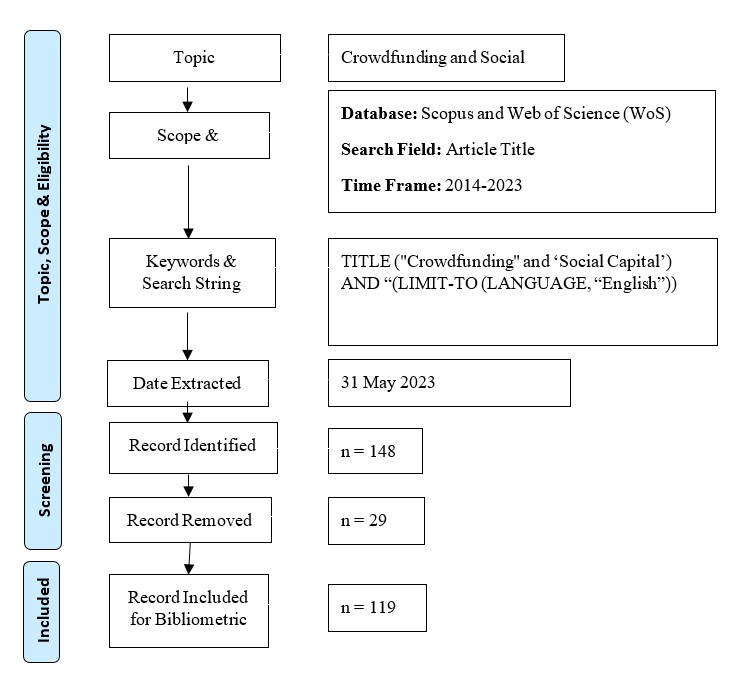
Figure 1. Flow diagram of the search strategy
Source: Authors own
Result and Discussion
The analysis for the extracted academic work in the search process was based on the following qualities: research productivity, document and source type, language of documents, most cited title, distribution of publications by countries, most active institutions, authorship analysis, keywords analysis, title and abstract analysis and citation analysis. Annual growth data until 2023 were also presented in the findings, whose frequency includes a percentage.
Documents and Source Types
Further study was done to analyse the type of documents and source type in which crowdfunding and social capital were published. Table 1 presents the results of documents’ types from year 2014 to 2023. Most of the studies on crowdfunding and social capital are articles (83.2%), followed by book chapters (6.72%) and conference papers (6.72%). Others were found as review and conference review with 2.52% and 0.84%.
The research also found that these documents are categorised into three source types, namely journals, books and conference proceedings. From 119 documents, 85.72% of the documents are published in journals, 6.72% published in the books and another 7.56% in the conference proceedings. As presented in Table 3, the language used for publications on crowdfunding and social capital is fully in English with 100%.
Table 1: Document Type
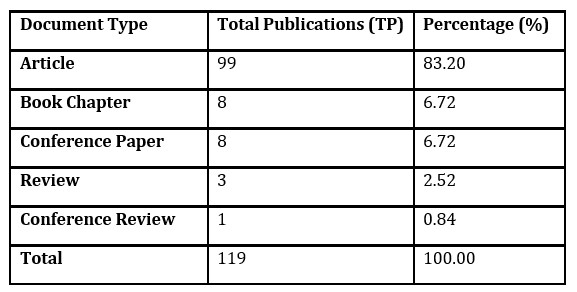
Table 2: Source Type
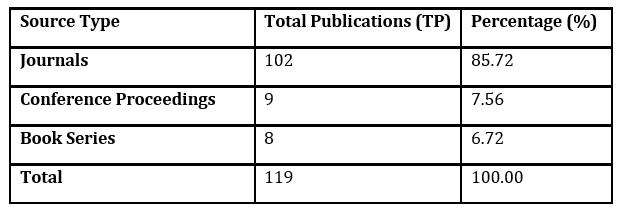
Table 3: Languages

Year of Publication – Evolution of Published Studies
Research productivity is examined in this study based on the total documents produced per year. As argued by Ahmi and Mohamad (2019), examining the publication years of documents enables researchers to understand the pattern of the chosen topic over time. Research on crowdfunding and social capital was firstly published in the year 2014. After the year 2014, it can be seen those publications on this topic have shown an increasing trend and gained 10.93% in 2017. However, the total of publications had slightly dropped to 10.08% from 2017 to 2018. After 2018, the total of publications on this topic seems inconsistent until 2021. The year 2022 was the highest year for publication in crowdfunding and social capital, with a total of 22 published articles (18.49%). Followed by 2019 (16.80%), 2020 (10.92%), 2023 (9.25%) and 2018 (10.08%).
Similarly, Figure 2 illustrates the growth of publication activities of this subject from 2014 to 2023. Figure 3 depicts the fluctuation of total documents published over 10 years. Referring to the pattern and growth, it seems that crowdfunding and social capital gained much interest among scholars at that time. This reveals the sustainability of crowdfunding is supported by the importance of social capital through social networks and relationship between fundraisers and backers.
Table 4: Years of Publications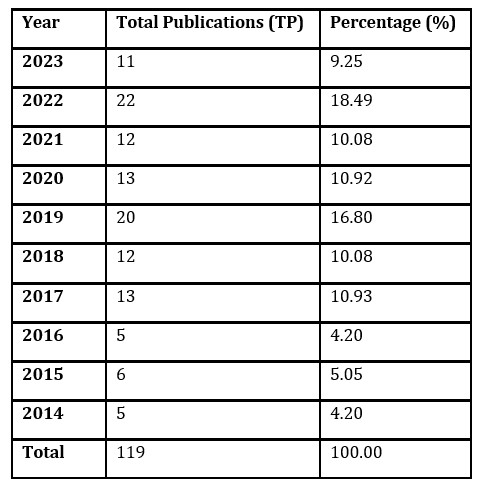

Figure 2. Documents by the Year 2014 to 2023
Subject Area
Table 5: Years of Publications
Table 5 presents the publication based on the subject area. It demonstrates that the largest number of publications were categorised under ‘economics, econometrics and finance’ with a total of 56 (47.06%) publications. This is followed by ‘social sciences’ (20.17%), 16.81% from computer science and another 15.96% come from decision sciences. The primary focus on economics, econometrics, and finance is because crowdfunding is principally based on fundraising phenomenon which assist start-up companies. To ensure the crowdfunding sustainability, a study involving social capital is essential as the latter is connected to social networks and relationship between entrepreneurs (start-ups) and the crowd of potential investors.
Most Active Source Titles
Table 6: Most Active Source Titles
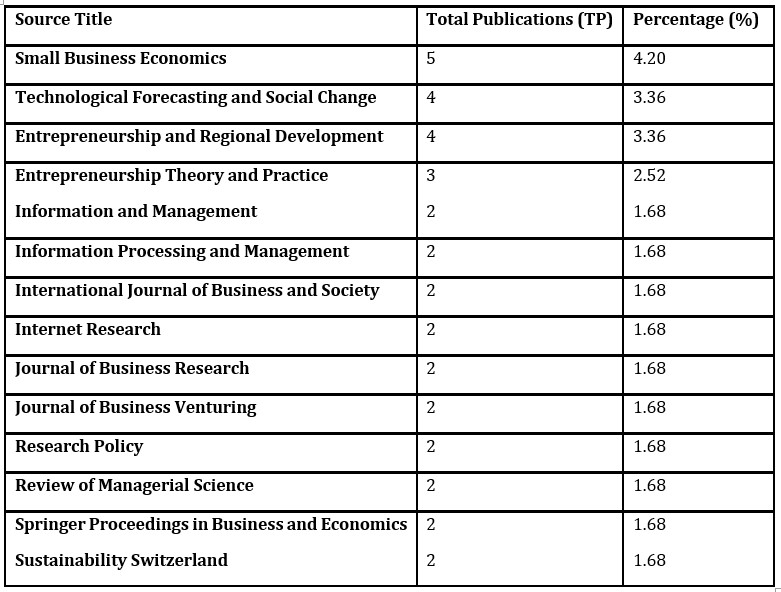
Table 6 reports the most active source titles on crowdfunding and social capital. The total number of publications depicted in Table 6 is not encouraging, as there are still relatively few publications from various sources. The highest source was small and business economics with 5 (4.20%). The second highest was Technological Forecasting and Social Change with 4 publications (3.36%) and the third highest also with 4 publications (4.65%) from Entrepreneurship and Regional Development. The fourth highest was entrepreneurship theory and practice with 3 publications (2.52%). From another 10 active source titles were only achieved 2 publications as depicted in Table 6.
Keywords’ Analysis
Table 7 shows the keywords that emerge as a result of the bibliometric search. This study analyses the top keywords that have been identified to classify some of the particular areas. Keywords such as crowdfunding, social capital, social capitals and crowdsourcing were among the prevalent keywords that occur and commonly being used in related publications. This study then further analyses the author’s keyword by producing the word cloud using Word Sift (Wordsift.org, 2021). With a maximum of 100 words, the result of the word cloud is presented in Figure 3. The figure showed the top 100 words (or part of the keywords) used from the published article on crowdfunding and social capital.
Table 7: Top Keywords
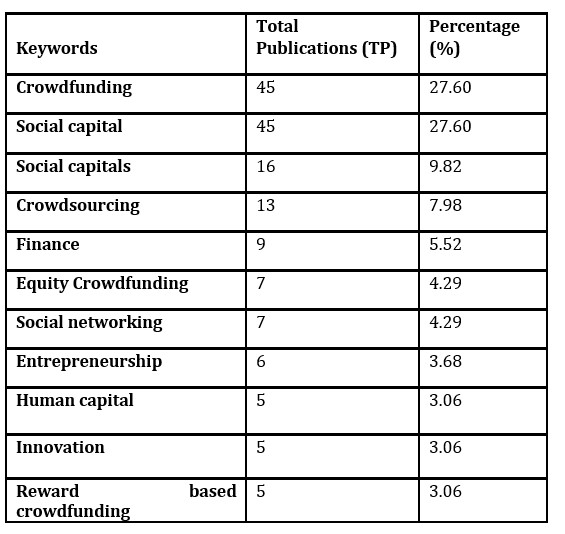
Table 8: Top Countries contributed to publications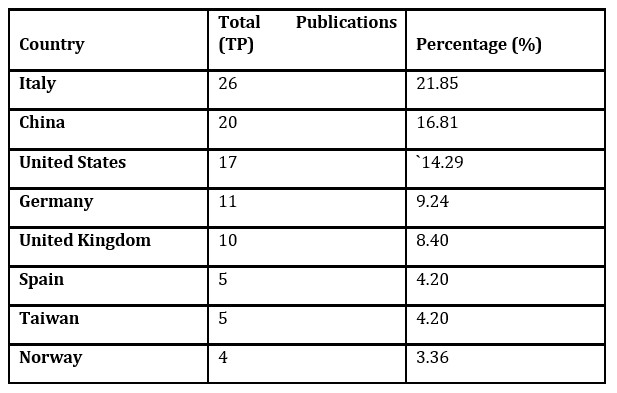
Geographical Distribution of Publications
This study also presents the most active countries that published documents on crowdfunding and social capital. Table 8 presented the top countries that contributed to the publications: Italy, China, the United States and Germany with more than 10 publications
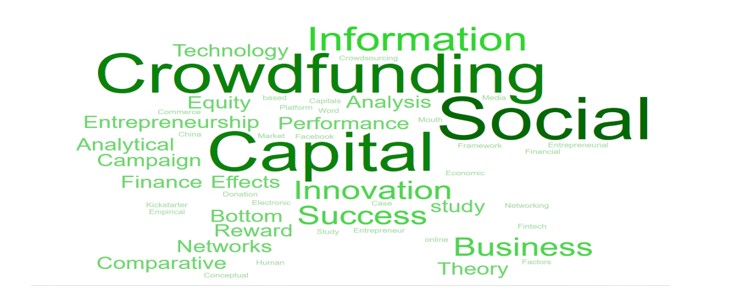 Figure 3. Word cloud of the keywords
Figure 3. Word cloud of the keywords
Text Analysis
The title and abstract from the documents gathered were analysed using VOS viewer software. The visualisation of the noun occurrences based on the title and abstract is illustrated in Figure 4 and 5. The strength of the occurrences is indicated by the size of the nodes, while the strength of the relationship is displaced by the thickness of the lines between nodes. Related words are grouped to show their relationship. The closer the items are located to each other, the stronger their relatedness (Ahmi,2021). The results of the analysis show that finance, innovation, social capital, social networking (online), and entrepreneurship are closely related and often occur together as depicted in Figure 4. Based on Figure 4, four different colours were generated from the analysis representing four essential groups from the analysis. However, only three different colours were generated from the analysis indicating three groups from the analysis from the Web of Science (WoS) database. This implies that Scopus database has published more articles on the connection between crowdfunding and social capital as compared to Web of Science database.
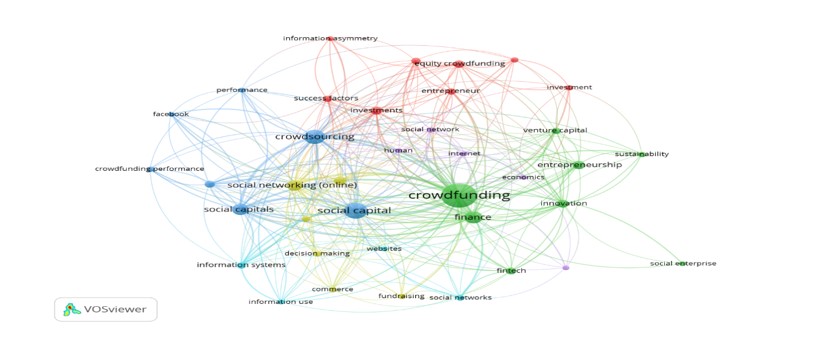
Figure 4. VOS viewer visualization of term co-occurrence network based on title and subtract fields from the Scopus database
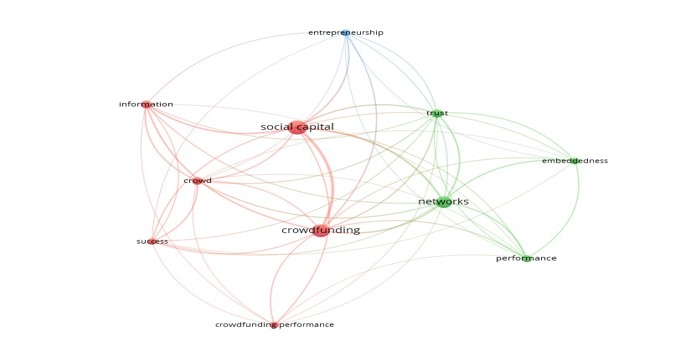
Figure 5. VOS viewer visualization of term co-occurrence network based on title and subtract fields from the Web of Science (WoS) database
Most Influential Institutions
Table 9 demonstrated the most influential institutions in publishing crowdfunding and social capital. The Politecnico di Milano and Scuola di Management, both from Italy, were the most influential institutions with 13 publications. These are followed by the University of Agder, Rheinisich Westfalische Technishe Hochschule Aachen and Nanjing University with publications amounting less than 5 publications per institution. The Washington State University Pullman, Texas Christian University, and Carson College of Business are three institutions from the United States with 2 publications. Similarly, three institutions from China namely the Nanjing University of Science and Technology, Hohai University, and University of Science and Technology have produced 2 publications respectively.
Table 9: Most Influential Institutions
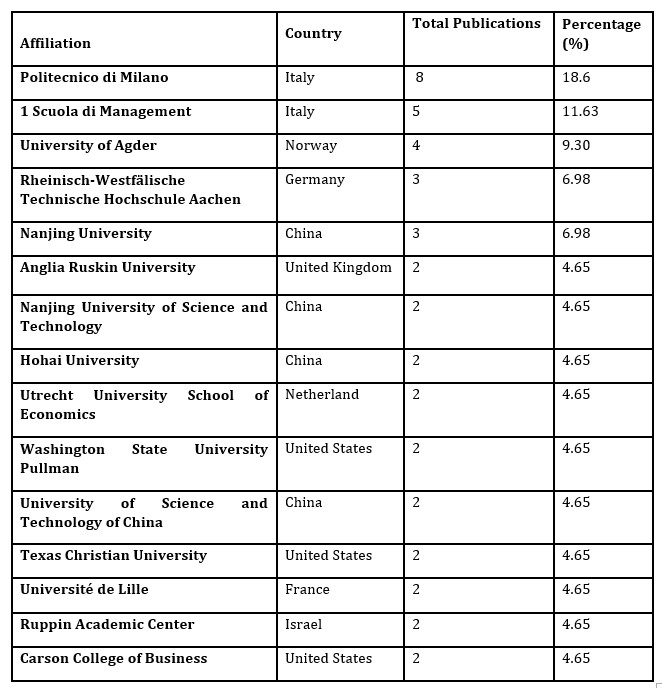
Citation Analysis
For citation analysis, this study has divided the result of citation metrics for Scopus and Web of Science (WoS) databases. Table 10 presented the citation metrics for the retrieved documents from Scopus database as 31 May 2023. The software of Harzing’s Publish or Perish was utilized to find the citation metric using the retrieved data from the Scopus database. The short description contains the number of citations with their citations per year, citation per paper and citations per author. There are 86 papers with 4353 citations averaging at 483.67 citations per year of crowdfunding and social capital. Each paper was cited 50.62 times and the total of h index and the g index was at 25 and 65 for all the publications. Table 11 exhibited the citation metrics for the retrieved document from the Web of Science. There are 33 papers with 1782 citations averaging at 54 citations per year of crowdfunding and social capital. The h index was 14 for all the publications for the WoS database.
The top 20 most cited articles in crowdfunding and social capital were exhibited in Table 12. As depicted in Table 12, the top three cited articles were found only in the Scopus database. Ahlers, Cumming, Günther, Schweizer (2015) with the title “Signalling in Equity Crowdfunding” was the most cited article to date with 942 total citations altogether. Followed by Skirnevskiy, Bendig, and Brettel (2017) with the article entitled “The Influence of Internal Social Capital on Social Creators’ Success in Crowdfunding” and Kleinert, Volkmann and Grünhagen (2020) with the title “Third-party Signals in Equity Crowdfunding: The Role of Prior Financing” with 148 citations and 63 citations respectively.
Of the top twenty papers, the vast majority deal primarily with the sustainability of crowdfunding as a result of social capital. The importance of social capital is the connection between the individuals embedded in social networks particularly the social relationship of entrepreneurs and backers. It is consistent with the study by Yousaf, Shakaki, Isac, Certi, and Hrebenciuc (2022) who asserted that social capital leads to better crowdfunding performance.
Table 10: Citations’ Metrics
Table 11: Citations’ Metrics
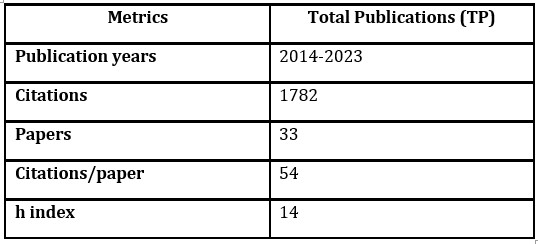
Table 12: Highly Cited Articles
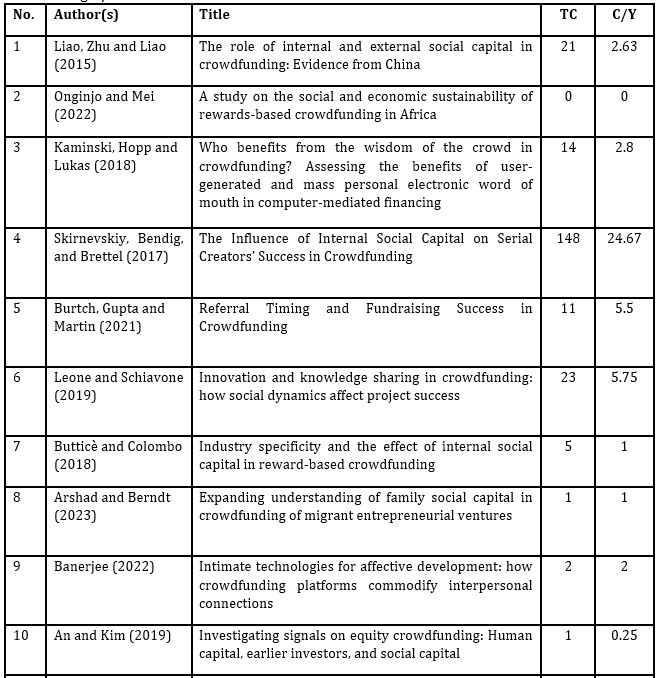
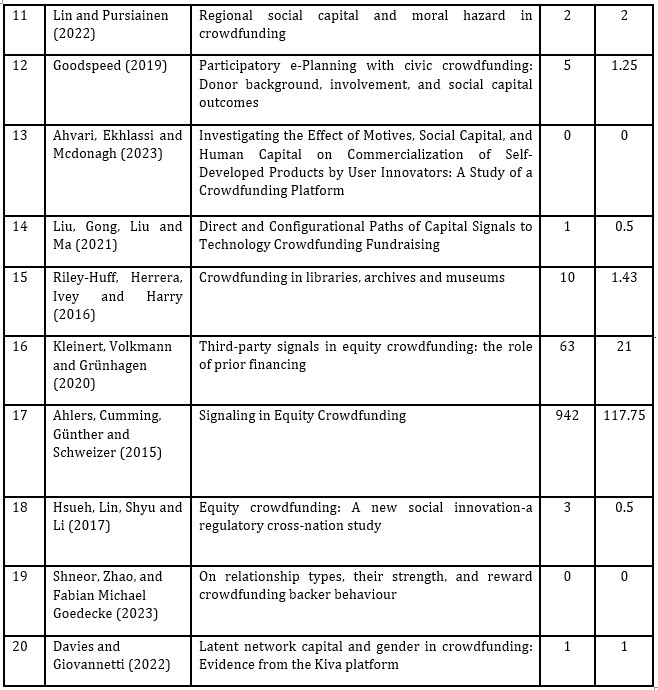
Conclusion and Implications
This paper revealed a bibliometric analysis of the crowdfunding and social capital theme in the current research agenda. A quantity of 119 articles documented with 86 and 33 in the Scopus and WoS databases respectively published between 2014 and 2023 were analysed. This topic is still not actively been discussed because some authors focused on other pertinent issues to crowdfunding and social capital based on the author’s field. The bibliometric technique enhances the process of selecting literature, as it identifies trends and productivity in research on crowdfunding and social capital. This analysis covers document and source types, year of publications, languages, subject areas, the most active source titles, keywords in titles and abstracts, and the geographical distribution of publications from 2014 to 2023. The results reveal that the topic of crowdfunding and social capital has attracted attention among scholars since 2014 with upward trend in publications. Most of the articles were published in journals and fully in English. In terms of contribution publication, Italy reported the highest number of contributing authors followed by China, the United States and Germany. The data indicates that a significantly larger number of articles are published and cited in the Scopus database, with nearly three times as many publications compared to the WoS database.
The most significant field in which the sources were produced comes from small business economics, technological forecasting, social change, entrepreneurship and regional development. The topic also appears in publications covering Information and management, information processing and management, international journal of business and society, Internet research, journal of business research, journal of business venturing, research policy, review of managerial science, springer proceedings in business and economics and sustainability Switzerland.
Although this study has made a few contributions, it has a limitation. Firstly, this study employed specific keywords to locate the initial list of scholarly published works as indexed by Scopus and Web of Science (WoS). Still, Scopus and WoS do not cover all accessible sources. Secondly, this study analysed publications with stringent limitations to avoid inappropriate search responses. This work may be improved in future to acquire more precise results when examining articles. In future, it is suggested to lengthen this work to other databases such as Google Scholar (GS) and Social Sciences Research Network (SSRN).
The implication of this study is significant for policymakers as the sustainability of crowdfunding relies much on the social capital namely social network or connections. Crowdfunding is becoming a digital platform demand for entrepreneurs for fund raising purpose. Thus, policymakers may need to provide some incentives such as tax exemption for backers or potential investors to encourage them participate in crowdfunding platforms. The success of crowdfunding depends on the campaign and the backers’ behaviour as well as motivational factors. Finally, extensive research is recommended to formulate better policies and programmes.
Acknowledgement
This project was funded by FRGS Grant, Ministry of Higher Education Malaysia with grant code (FRGS/1/2022/SS01/UITM/02/3).
References
- Ahlers, G. K. C., Cumming, D., Günther, C. and Schweizer, D. (2015), ‘Signalling in Equity Crowdfunding,’ Entrepreneurship Theory and Practice, 39(4), 955-980. https://doi.org/10.1111/etap.12157
- Ahmi, A. (2021). Bibliometric analysis for beginners (1st ed.). Kuala Lumpur, Malaysia: Academic Research Society of Malaysia. Retrieved from https://www.aidi-ahmi.com/index.php/bibliometric-analysis-for-beginners
- Ahmi, A., and Mohamad, R. (2019). Bibliometric Analysis of Global Scientific Literature on Web Accessibility. International Journal of Recent Technology and Engineering, 7(6), 250–258.
- Ahvari, H., Ekhlassi, A. and McDonagh, J. (2023). “Investigating the Effect of Motives, Social Capital, and Human Capital on Commercialization of Self-Developed Products by User Innovators: A Study of a Crowdfunding Platform,” International Journal of Innovation and Technology Management (IJITM), World Scientific Publishing Co. Pte. Ltd., vol. 20(01), pages 1-22, February.
- An, J. and Kim, H.-W. (2019). Investigating Signals on Equity Crowdfunding: Human Capital, Earlier Investors, and Social Capital. Asia Pacific Journal of Information Systems 29(2):283-307. DOI:14329/apjis.2019.29.2.283
- Arshad, N. and Berndt, A. (2021). Expanding understanding of family social capital in crowdfunding of migrant entrepreneurial ventures. Journal of Enterprising Communities: People and Places in the Global Economy. ISSN: 1750-6204.
- Banerjee, S. A. (2022). “Intimate technologies for affective development: how crowdfunding platforms commodify interpersonal connections,” Third World Quarterly, Taylor & Francis Journals, vol. 43(3), pages 580-598, March.
- Bapna, S. (2019) ‘Complementarity of Signals in Early-stage Equity Investment Decisions: Evidence from a Randomized Field Experiment,’ Management Science, 65(2), 933–952. https://doi.org/10.1287/mnsc.2017.2833
- Beaulieu, T., Sarker, S. and Sarker, S. (2015), ‘A Conceptual Framework for Understanding Crowdfunding,’ Communications of the Association for Information Systems, 37 (1) https://doi.org/10.17705/1CAIS.03701
- Belleflamme, P., Lambert, T. and Schwienbacher, A. (2014), ‘Crowdfunding: Tapping the Right Crowd’, Journal of Business Venturing, 29(5), 585–609. https://doi.org/10.1016/j.jbusvent.2013.07.003
- Burt, RS. (1992) ‘Structural Holes: The Social Structure of Competition’, University of Illinois at Urbana Champaign’s Academy Entrepreneurial Leadership History Research References in Entrepreneurship. https://ssrn.com/abstract=1496205
- Burtch, G., Gupta, D. and Martin, P. (2021). “Referral Timing and Fundraising Success in Crowdfunding,” Manufacturing & Service Operations Management, INFORMS, vol. 23(3), pages 676-694, May.
- Burtch, G., Ghose, A. and Wattal, S. (2013), ‘An Empirical Examination of the Antecedents and Consequences of Contribution Patterns in Crowd-Funded Markets’, Information Systems Research, 24(3), 499–519. http://www.jstor.org/stable/42004279
- Butticè, V., Colombo, M. G. and Wright, M. (2017), ‘Serial Crowdfunding, Social Capital, and Project Success’, Entrepreneurship Theory and Practices, 41 (2), 183–207. http://DOI:10.1111/etap.12271
- Butticè, V. and Colombo, M. G. (2018). Industry specificity and the effect of internal social capital in reward-based crowdfunding in book: Entrepreneurial Ecosystems and the Diffusion of Startups. DOI:10.4337/9781784710064.00010
- Cai, W., Polzin, F. and Stam, E. (2020), ‘Crowdfunding and Social Capital: A Systematic Review using a Dynamic Perspective’ Technological Forecasting & Social Change, 162, 1-22
- https://doi.org/10.1016/j.techfore.2020.120412
- Chen J., Cheng X., Gong S. X. and Tan, Y. (2014), ‘Do Higher Value Firms Voluntarily Disclose More Information? Evidence from China’, The British Accounting Review, 46, 18–32. https://doi.org/10.1016/j.bar.2013.06.003
- Claridge, T. (2018), ‘Criticisms of Social Capital Theory: and Lessons for Improving Practice’, Social Capital Research and Training, 1, 1-8 https://zenodo.org/records/8008320
- Coleman, J. S. (1988). Social Capital in the Creation of Human Capital. American Journal of Sociology. Vol. 94, Supplement: Organizations and Institutions: Sociological and Economic Approaches to the Analysis of Social Structure (1988), pp. S95-S120 (26 pages)
- Colombo, M. G., Franzoni, C. and Rossi-Lamastra, C. (2015), ‘Internal Social Capital and the Attraction of Early Contributions in Crowdfunding’, Entrepreneurship Theory and Practice, 39, 75-100. https://doi.org/10.1111/etap.12118
- Dai, H. and Zhang, DJ. (2019), ‘Prosocial Goal Pursuit in Crowdfunding: Evidence from Kickstarter’, Journal of Marketing Research, 56(3), 498-517. https://doi.org/10.1177/0022243718821697
- Davies, W. E. and Giovannetti, E. (2022). “Latent network capital and gender in crowdfunding: Evidence from the Kiva platform,” Technological Forecasting and Social Change, Elsevier, vol. 182(C).
- Goodspeed, R. (2019). “Participatory E-Planning with Civic Crowdfunding: Donor Background, Involvement, and Social Capital Outcomes,” International Journal of E-Planning Research (IJEPR), IGI Global, vol. 8(2), pages 68-87, April.
- Granovetter, M. (1992). Problems of Explanation in Economic Sociology, In Nohria, N., Eccles, R. (Eds.), Network and Organizations: Structure, Form and Action. Harvard Business School, Boston, Mass.
- Hoque, M. N., Mohamed, N., Azad, A. K., Nuruzzaman, A. F. M., and Zaid, B. M. Y. (2023). Strengthening accountability and governance of crowdfunding: Enhancing funding of higher educational institutions. Journal of Nusantara Studies, 8(3), 300-321. http://dx.doi.org/10.24200/jonus.vol8iss3pp300-321
- Hsueh, R-T, Lin, K-C., Shyu, J. Z. and Li, K-P. (2016). Equity crowdfunding: A new social innovation-a regulatory cross-nation study. 2016 Portland International Conference on Management of Engineering and Technology (PICMET), Honolulu, HI, USA, 2016, pp. 1346-1350, doi: 10.1109/PICMET.2016.7806539.
- Karlan, D. and John AL. (2007), ‘Does Price Matter in Charitable Giving? Evidence from a Large-Scale Natural Field Experiment’, American Economic Review, 97 (5): 1774-1793. https://DOI.org/10.1257/aer.97.5.1774
- Kleinert, S., Volkmann, C & Grünhagen, M. (2020). “Third-party signals in equity crowdfunding: the role of prior financing,” Small Business Economics, Springer, vol. 54(1), pages 341-365, January.
- Kaminski, J., Hopp, C. and Lukas, C. (2018). Who benefits from the wisdom of the crowd in crowdfunding? Assessing the benefits of user-generated and mass personal electronic word of mouth in computer-mediated financing. Journal of Business Economics 88(2), DOI:1007/s11573-018-0899-3
- Kleinert, S., Volkmann, C. and Gruenhagen, M. (2020). Third-party signals in equity crowdfunding: the role of prior financing. Small Business Economics 54(1). DOI:1007/s11187-018-0125-2
- Kuppuswamy, V. and Bayus, BL. (2018), ‘Crowdfunding Creative Ideas: The Dynamics of Project Backers’. In The economics of Crowdfunding, 151–182. Palgrave Macmillan. https://doi.org/10.1007/978-3-319-66119-3_8
- D. and Schiavone, F. (2018). Innovation and knowledge sharing in crowdfunding: how social dynamics affect project success, 803-816 https://doi.org/10.1080/09537325.2018.1554858
- Liao, C., Zhu, Y., and Liao, X. (2015). The Role of Internal and External Social Capital in Crowdfunding: Evidence from China. Revista De Cercetare. Si Interventie Sociala 49:187-204.
- Liu. T., Gong, X., Liu. Z. and Ma (2021). Direct and Configurational Paths of Capital Signals to Technology Crowdfunding Fundraising. IEEE Transactions on Engineering Management, 99, 1-16. DOI:10.1109/TEM.2021.3068524
- Lin, T-C, and Pursiainen, V. (2018), ‘Fund What You Trust? Social Capital and Moral Hazard in Crowdfunding. (March 28, 2022). https://doi.org/10.2139/ssrn.3088905
- List, J. A. and Price, M. K. (2009), ‘The Role of Social Connections in Charitable Fundraising: Evidence from a Natural Field Experiment’, Journal of Economic Behavior and Organization, 69(2), 160-169. https://doi.org/10.1016/j.jebo.2007.08.011
- Martínez-Climent, C., Zorio-Grima, A. and Ribeiro-Soriano, D. (2018), ‘Financial Return Crowdfunding: Literature Review and Bibliometric Analysis’, International Entrepreneurship and Management Journal, 14(3), 527–553. https://doi.org/10.1007/s11365-018-0511-x
- Mochkabadi, K. and Volkmann, C.K. (2020), “Equity crowdfunding: a systematic review of the literature”, Small Business Economics, 54, 75-118 https://doi.org/10.1007/s11187-018-0081-x.
- Moher D, Liberati A, Tetzlaff, J. and Altman, D. G. (2009). Preferred reporting items for systematic reviews and meta-analyses: the PRISMA statement. PLoS Medicine 6(7): e1000097. The PRISMA Group
- Mollick, E. (2014), ‘The Dynamics of Crowdfunding and Exploratory Study’, Journal of Business Venture, 29(1), 1-16.
- A. and Block, J. H. (2014). Crowdfunding: A Literature Review and Research Directions. Crowdfunding in Europe, FGF Studies in Small Business and Entrepreneurship, DOI 10.1007/978-3-319-18017-5_3
- Nahapiet, J. and Ghoshal, S. (1998), ‘Social Capital, Intellectual Capital and the Organizational Advantage’, Academic Management. Review, 23 (2), 242-266.
- Onginjo, J. and Mei, Z. D. (2022). A study on the social and economic sustainability of rewards-based crowdfunding in Africa. Environment Development and Sustainability. DOI:1007/s10668-022-02451-y
- Payne, G. T., Moore C. B., Griffis S. E. and Autry, C. W. (2011), ‘Multilevel Challenges and Opportunities in Social Capital Research’, Journal of Management, 37: 491-520. https://doi.org/10.1177/01492063103724
- Popescul, D., Radu L. D., Pavaloaia, V. D. and Geogescu, M. R. (2020), ‘Psychological Determinants of Investor Motivation in Social Media Based Crowdfunding Projects: A Systematic Review’, Frontier Psychology, 11:588121. http://doi.10.3389/fpsyg.2020.588121.
- Riley-Huff, D. A., Herrera, K., Ivey, S. and Harry, T. (2016). Crowdfunding in libraries, archives and museums. The Bottom Line Managing Library Finances 29(2):67-85.
- Shane, S. A. and Cable, D. M. (2002), ‘Network Ties, Reputation, and the Financing of New Ventures’, Management Science, 48(3), 364-381. http://doi.org/10.1287/mnsc.48.3.364.7731
- Shneor, R., Zhao, L. and Goedecke, J. (2023). On relationship types, their strength, and reward crowdfunding backer behaviour. Journal of Business Research 154(1):113294, DOI:1016/j.jbusres.2022.08.058
- Skirnevskiy, V., Bendig, D. and Brettel, M. (2017), ‘The Influence of Internal Social Capital on Serial Creators’ Success in Crowdfunding’, Entrepreneurship Theory and Practice, 41(2), 209-236. https://doi.org/10.1111/etap.12272
- Vismara, S. (2016) ‘Equity Retention and Social Network Theory in Equity Crowdfunding’, Small Business Economics, 46(4), 579-590. http://DOI10.1007/s11187-016-9710-4
- Vismara, S. (2018) ‘Information Cascades among Investors in Equity Crowdfunding’, Entrepreneurship Theory and Practice, 42(3), 467-497. https://doi.org/10.1111/etap.12261
- Wang, L. and Graddy, E. (2008), ‘Social Capital, Volunteering, and Charitable Giving’, Voluntas, 19, 23–42. https://doi.org/10.1007/s11266-008-9055-y
- Webster, J. and Watson, R.T. (2002), “Analyzing the past to prepare for the future writing a literature review”, MIS Quarterly, 26(2): p 13–23.
- Yousaf, Z., Shakaki, O., Isac N., Cretu, A. and Hrebenciuc, A. (2022), ‘Towards Crowdfunding Performance through Crowdfunding Digital Platforms Investigation of Social Capital and Innovation Performance in Emerging Economies’, Sustainability, 14(15), 9495, https://doi.org/10.3390/su14159495
- Zakaria, R., Ahmi, A., Ahmad, A. H. and Othman, Z. (2021). Worldwide melatonin research: a bibliometric analysis of the published literature between 2015 and 2019. Chronobiology International, 38(1), 27-37.



















